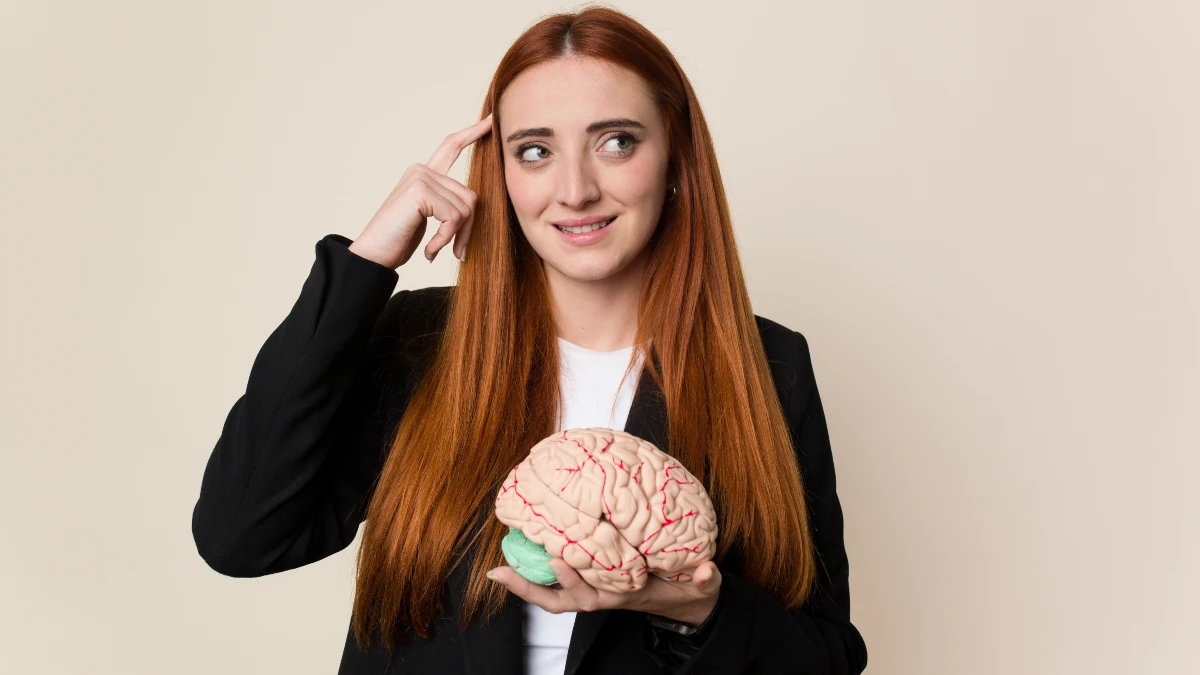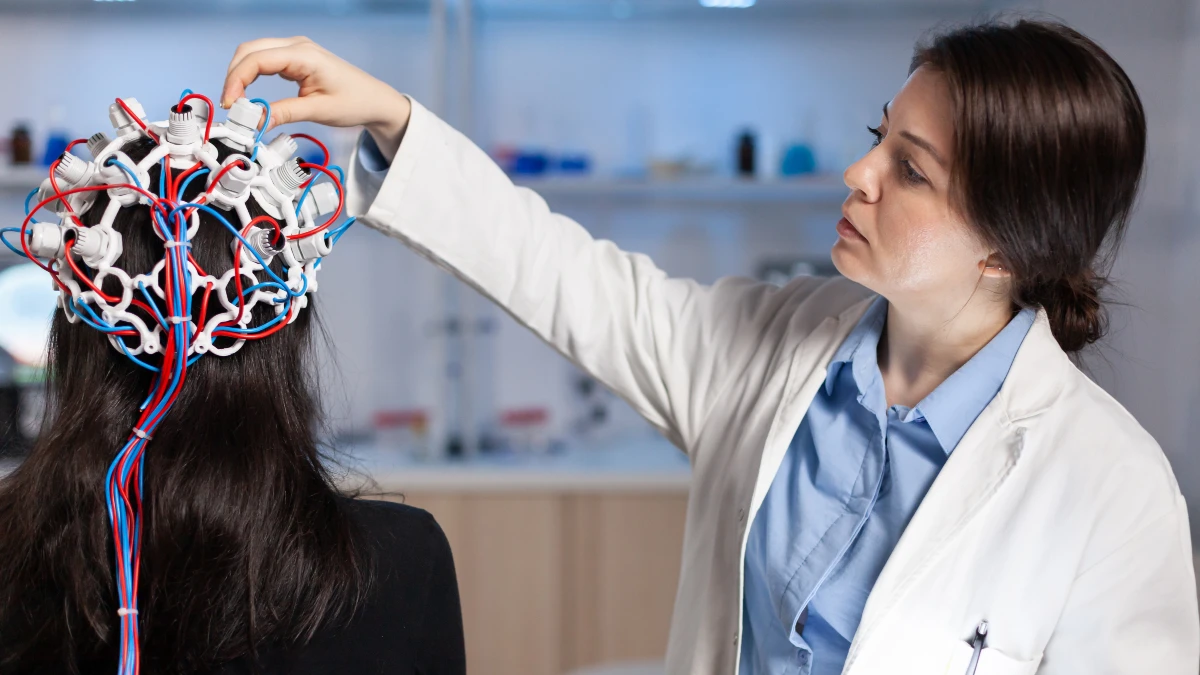Your brain has its own fertilizer, a protein called BDNF that helps you learn faster and stay sharp. But modern life drains your levels, leading to brain fog and a slower mind. The good news is you are in control.
This guide is your blueprint for boosting this “Miracle-Gro” for your brain. You will learn exactly what BDNF is and get seven simple, science-backed strategies to increase it naturally. Get ready to build a stronger, more resilient brain for life.
What is BDNF? A Simple Guide to Your Brain’s Master Protein
Your Brain’s Super-Protein
Understanding BDNF and Its Three Critical Roles
The Architect
Spurs **neurogenesis**: the growth of brand-new brain cells, especially in the hippocampus (your memory hub).
The Electrician
Boosts **neuroplasticity**: the strengthening of connections (synapses) that lets you learn skills and adapt.
The Bodyguard
Defends your neurons against stress, toxins, and decline. Low BDNF is linked to depression and neurodegenerative diseases.
How to Naturally Boost Your BDNF
- 🏃 Exercise: The #1 way.
- 😴 Sleep: Quality sleep is essential.
- 🐟 Diet: Omega-3s & dark berries.
- ☀️ Sunlight: Vitamin D helps.
- 🧘 Manage Stress: Chronic stress lowers it.
BDNF is a protein that acts like a growth booster for your brain. The name sounds complicated, but its job is simple. Think of it as your brain’s architect, electrician, and bodyguard.
How BDNF Works: An Architect, Electrician, and Bodyguard for Your Brain
BDNF does three main jobs that are vital for your brain’s health and performance:
- It Builds New Brain Cells (The Architect): BDNF tells your body to grow new brain cells. This happens a lot in the part of your brain that controls learning and memory, called the hippocampus.
- It Rewires Your Brain (The Electrician): BDNF helps your brain change and adapt when you learn new things. It strengthens the connections between brain cells so they can talk to each other better. This is how you learn. BDNF makes sure the wiring is strong.
- It Protects Your Brain Cells (The Bodyguard): BDNF also keeps your current brain cells safe. It defends them from damage caused by stress, toxins, and getting older.
So, when you learn a new skill or get in a better mood, that’s BDNF at work. Boosting this protein isn’t just a trick. It’s a real way to build a better brain.
7 Ways to Naturally Boost BDNF
You don’t need fancy gadgets or pills to boost your brain’s master protein. You just need to make smart, consistent lifestyle choices. These seven tips work together. Doing one helps the others work even better.
This table gives you a quick look at the seven pillars. You can see the main ideas before we get into the details.
1. How Moving Your Body Grows Your Brain

Want to boost BDNF? The best way is exercise. Nothing else comes close. Dr. John Ratey, a brain expert, says exercise provides the “spark” that gets your brain ready for learning, mood control, and growth.
Here’s how it works. Exercise sends more blood, oxygen, and food to your brain. It directly increases the amount of BDNF in your blood, which then goes to your brain to feed your brain cells. It also releases other helpful growth factors that work with BDNF to build a better brain.
Your Plan for a Brain-Boosting Workout
Any movement is good, but some types of exercise give you more brain benefits.
How hard you work out seems to be the most important factor. One study found that just six minutes of high-intensity interval training (HIIT)—like six one-minute sprints on a bike—raised BDNF levels four to five times more than a slow 90-minute bike ride. Short, intense workouts are a very efficient way to get a big release of this brain fertilizer. This may be because intense exercise produces lactate. For a long time, people thought lactate was just waste. Now we know it’s a signal and a fuel source for the brain. The study found that the spike in BDNF matched the spike in lactate. This means lactate may tell the brain to make more BDNF.
Cardio gets a lot of attention for brain health, but one major analysis found that resistance training might be the single best exercise for increasing BDNF. This is important. It shows that lifting weights, using bands, or doing push-ups and squats are also great for your brain.
The best plan uses different types of movement. Studies show that aerobic exercise, weight training, and a mix of both all raise BDNF levels. A varied routine is the best approach. A regular exercise habit is an investment in your brain’s future. One study showed that adults who walked for 40 minutes three times a week grew their hippocampus by 2%. This reversed age-related brain shrinkage. Exercise is the best insurance policy against your brain getting older.
Sample Weekly Plan
- Monday & Thursday: Weight Training (45 minutes, full body)
- Tuesday & Saturday: High-Intensity Interval Training (20 minutes total). Example: 6 rounds of 1-minute max effort on a bike or sprinting, then 1-2 minutes of easy recovery.
- Wednesday: Moderate Cardio (40-minute fast walk, jog, or dance class)
- Friday & Sunday: Active Recovery (Stretching or gentle yoga)
Helpful HIIT Apps for 2025
- Centr: A great all-around fitness app with lots of workouts, including HIIT for beginners, plus meal plans and meditation.
- Nike Training Club: The best free app. It has a huge library of workouts, including many HIIT sessions you can filter by time and intensity.
- Fiit: A good choice for beginners. Its group classes are free and can help you build a habit.
- Shred App: This app uses AI to make custom workouts that change as you get stronger, like a virtual personal trainer.
2. How to Feed Your Brain Cells

The food you eat does more than give you energy. Certain foods send signals to your brain. Some foods tell your brain to make more BDNF. A brain-healthy diet gives your brain the parts it needs to build new cells. It also calms down inflammation, which can lower BDNF and hurt brain cells.
The food on your plate is a set of instructions for your body. Eating blueberries isn’t just about vitamins. It’s about sending a signal to your brain to make more “Miracle-Gro.”
Your BDNF-Boosting Shopping List
A diet that boosts BDNF focuses on three things: colorful plants, omega-3 fats, and a healthy gut.
Research here is very promising. Studies show that compounds in berries and dark chocolate can raise BDNF and improve memory. A recent human trial found that a drink rich in these compounds raised BDNF and improved scores on thinking tests.
Eat a rainbow of foods. Choose dark-colored fruits and vegetables like blueberries, blackberries, spinach, and kale. Enjoy dark chocolate (70% cocoa or more) and drink green tea.
These two fats are building blocks for your brain cells. A diet with plenty of them helps your brain and can boost BDNF. One study on people with bipolar disorder found that taking 2 grams of omega-3s a day for two months raised BDNF and lowered depression. On the other hand, not getting enough omega-3s can lower BDNF and hurt your memory. The research isn’t always perfectly consistent, but the trend is very positive.
Try to eat fatty fish like salmon, mackerel, and sardines two or three times a week. If you don’t eat fish, a good supplement is a smart idea.
Your gut and brain are always talking to each other. The health of the bacteria in your gut has a big effect on your brain and BDNF levels.
Eat fermented foods like plain yogurt, kefir, kimchi, and sauerkraut. Certain probiotics, like Lactobacillus plantarum, have been linked to better memory and more BDNF.
It’s also important to cut out foods that hurt BDNF. Studies show that diets high in sugar, high-fructose corn syrup, and processed foods can lower BDNF and harm brain function.
3. How to Challenge Your Mind

Your brain follows a “use it or lose it” rule. It won’t waste energy building new pathways unless you challenge it. When you learn something new and complex, you create a “demand” for BDNF. This tells your brain it needs to grow to meet the challenge.
How to Train Your Brain Like a Muscle
A good mental workout includes both big learning projects and smaller skill practices. Just playing simple brain games is like only doing bicep curls at the gym. You miss out on the full-body benefits.
This is the best way to stimulate your brain. The focus needed to learn an instrument, a new language, or a craft like coding forces your brain to build strong new networks.
This is not just relaxing. It’s active training for your attention. A lot of research shows that meditation can raise BDNF levels. It likely works by lowering the stress hormone cortisol and reducing inflammation, both of which hurt BDNF.
These apps are not a replacement for real-world learning. But some good ones can help you sharpen specific skills like processing speed and memory.
4. Why You Need Quality Sleep

The link between sleep and BDNF is a bit complex, but it’s very important. The research shows a difference between long-term sleep problems and just one bad night. Chronic insomnia and poor sleep are linked to more stress and much lower baseline BDNF levels. This makes sense. A lack of good sleep is a major stress on your body.
Oddly, some studies found that a single night of no sleep can cause a temporary increase in BDNF. Think of it as your brain’s emergency response to the stress. But this isn’t a good thing long-term. It doesn’t change the fact that you need consistent, quality sleep for a healthy brain.
Healthy sleep is when your brain does its most important cleaning and repair work. It clears out waste, fixes damage, and locks in memories. This memory process is where BDNF’s work gets finalized. Exercise and learning during the day create the potential for new brain connections. But it is during deep sleep that these connections get strong and become long-term memories. Without good sleep, the “Miracle-Gro” is used, but the seeds of learning never fully grow.
How to Get Better Sleep for Your Brain
- Keep a Consistent Schedule: Go to bed and wake up around the same time every day, even on weekends. This sets your body’s internal clock.
- Make Your Bedroom a Sleep Haven: Keep your room cool, dark, and quiet. Use blackout curtains or an eye mask if you need to.
- Turn Off Screens an Hour Before Bed: The blue light from phones and computers stops your brain from making melatonin, the sleep hormone. Create a screen-free routine to wind down.
- Watch What You Eat and Drink: Avoid caffeine after 2 PM. Don’t eat big meals or drink too much alcohol right before bed, as they can mess up your sleep.
5. How to Use Sunlight and Heat

A little bit of good stress can make your brain stronger. This is called hormesis. Brief, manageable stressors can trigger a response in your cells that makes them tougher. Sunlight and heat are two natural ways to do this. They can turn on protective pathways in your brain, including the one that makes BDNF.
This idea probably comes from our evolution. Our ancestors faced constant challenges from the environment. The brains that survived were the ones that responded to stress by getting stronger. BDNF is a key part of this response. By using these environmental stressors in a smart way, we can tap into our own survival systems to make our brains better.
How to Use Your Environment for a Better Brain
Sunlight helps your body make Vitamin D, which is vital for your brain. Lots of research shows a clear link: more Vitamin D means more BDNF. Higher Vitamin D is linked to better thinking, better mood, and a lower risk of brain decline. One review found that for every 10 ng/mL increase in Vitamin D in the blood, there was a 15% increase in BDNF.
Try to get 15-20 minutes of morning or late afternoon sun on your arms and legs without sunscreen. The sun is less intense at these times. In the winter, or if you live far from the equator, a Vitamin D3 supplement is often a good idea.
6. Why You Need to Connect with Others

Humans are social animals. Our brains grew and developed in communities, not alone. Because of this, real social connection is not a nice-to-have. It’s a biological need for a healthy brain. Talking with others is a complex mental workout. It fires up brain circuits for attention, memory, and empathy.
The opposite is also true. Being lonely is bad for your brain. Research shows that long-term isolation is linked to a smaller memory center and lower levels of BDNF. It also raises levels of the stress hormone cortisol, which can damage brain cells. The link to long-term brain health is clear: one large study found that lonely people had a 40% higher risk of developing dementia.
Social connection does two things. It stimulates your brain directly. It also protects you from chronic stress, which is one of the biggest things that lowers BDNF. Strong social ties help us manage our emotions and reduce stress hormones. This protects the BDNF we have and helps us make more.
How to Build Your Social Brain
- Focus on Quality, Not Quantity: The goal isn’t to have a full calendar. The brain benefits come from real conversations where you are focused and engaged.
- Schedule Social Time: In our busy lives, social time is often the first thing to go. Treat it like an important meeting. Make plans to call, have lunch, or do activities with friends and family.
- Join a Group or Class: This is a great strategy because it combines social time with learning something new (Pillar 3). Joining a book club, sports team, or volunteer group gives you regular social time built around something you enjoy.
- Have Deeper Conversations: Try to go beyond small talk. Talking about ideas and sharing different points of view is a great workout for your brain.
7. How to Eat Less, But Smarter

The last pillar, like heat and intense workouts, uses the idea of good stress. Intermittent fasting (IF) puts a mild, short-term stress on your body. This stress can turn on protective and repair pathways in your cells. One key effect is that it pushes your body to use ketones for fuel instead of just sugar. Ketones are made from fat. They are a great fuel for the brain and can also signal your body to turn on protective genes, including the one for BDNF.
It’s important to be careful with this strategy. The research here is a bit mixed. In animals, fasting boosts BDNF. In people, the results vary. Some studies show a rise in BDNF with fasting, while others show no change or even a drop. One of the best human studies found that a 20-hour fast by itself did not change BDNF levels. This suggests that how you respond to fasting can depend on many things, like the fasting schedule and your own body.
How to Try Intermittent Fasting
Because the results in people can vary, it’s best to think of fasting as an advanced strategy. You can add it on top of the other, more proven pillars.
- Start Simple with Time-Restricted Eating: The easiest way to start is the 16:8 method. You eat all your food for the day in an 8-hour window (like from 12 PM to 8 PM) and fast for the other 16 hours.
- Combine Fasting with Exercise: This might be the most important finding from the research. Fasting alone might not be a magic bullet. But when you combine it with exercise, it’s powerful. One study found that a low-calorie diet raised BDNF by 20%. But combining that diet with HIIT boosted BDNF by an amazing 38%. This shows they work very well together. Fasting may not directly trigger BDNF, but it seems to get the brain ready to respond better to the powerful BDNF signals from an intense workout.
- Important Note: Intermittent fasting is not for everyone. You should talk to a doctor before you start any fasting plan. This is especially true if you are pregnant, underweight, have a history of eating disorders, or have a medical condition like diabetes.
Conclusion
Your brain’s health isn’t set in stone. It’s the result of a conversation between your genes and your lifestyle. You have a big say in that conversation. BDNF is the molecule at the center of it all. It’s the physical proof of your brain’s ability to grow, learn, and be strong.
The seven pillars in this guide—Movement, Diet, Mind Challenge, Sleep, Environment, Social Connection, and Smart Eating—are not just a list of options. They are a complete system for a better brain. Exercise creates the need for growth. A good diet provides the building blocks. Quality sleep locks in the gains. And using mental challenges, good stress, and social time creates the perfect environment for a healthy brain to grow.
Don’t leave your brain’s health to chance. The science is clear, and the tools are simple. It’s time to pick up the watering can. With these seven strategies, you have what you need to apply the “Miracle-Gro” and grow a sharper, stronger, and healthier mind for life.


